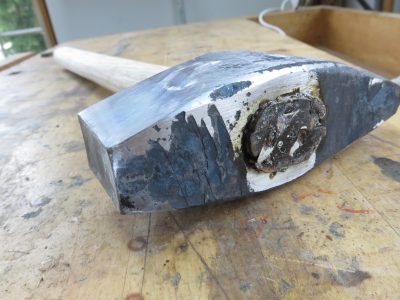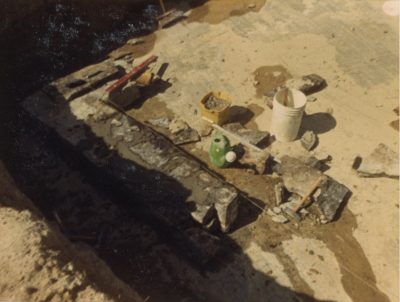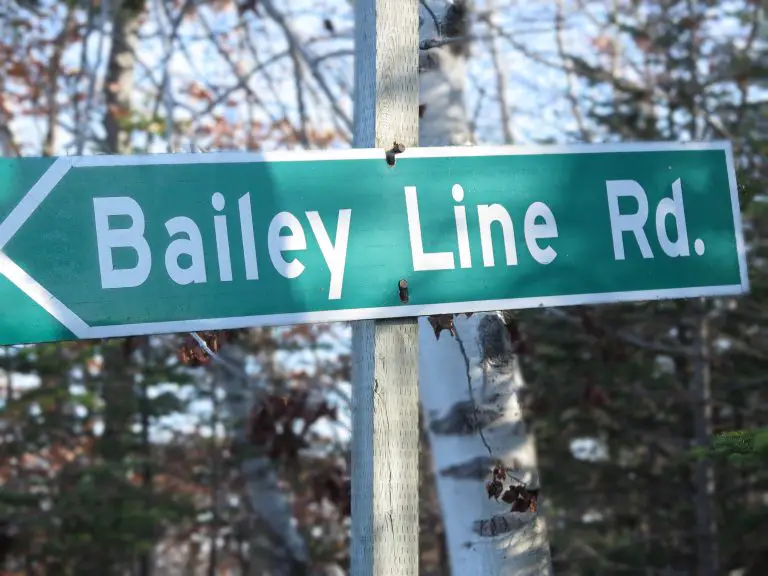This is chapter 12 in my book The Bailey Line Road Chronicles, the 30-year story about moving from the city to live a modern homestead life deep in the country on Manitoulin Island, Canada. This is a reader-supported project. The only funding I get is from readers like you. Missed Chapter 11? Click here to read it. Want to start from the beginning? Click here for Chapter 1.
Can I get your help? Click here to see how a few dollars a month from you can be a big help to me, plus get you a copy of the completed Bailey Line Road Chronicles. A big thank you to the handful of sponsors whose support is providing a total of $49 a month as of August 18, 2018. I appreciate it!
******************************
As I’ve mentioned before, my wife Mary and I decided to build our homestead house using local stone we quarried and shaped ourselves, and the process taught us more than just how to build. Like many traditional skills, there’s nothing intellectually complicated about building a structural wall from raw limestone. It’s easy to understand. The difficulty with structural stonework lies elsewhere, as I’ll explain. In the mean time, here are the mechanics of building with sedimentary stone as Mary and I did it building the basement of our house . . .
 The bedrock of Manitoulin is called limestone by locals, but scientists call it dolomite because it has a high magnesium content. Like many sedimentary rocks, limestone was laid down in layers that solidified underwater, so it tends to have parallel surfaces that lend themselves to building right out of the ground. Manitoulin Island is the northern limit of a huge limestone ridge that runs down the middle of southern Ontario. I’m told that the limestone here is about 300 feet thick, sitting on harder, underlying igneous rock that you can see at the surface of the Precambrian Shield north of Manitoulin on the mainland. Local limestone was a handy material for early settlers building foundations for barns, houses, churches and commercial buildings, so they used it.
The bedrock of Manitoulin is called limestone by locals, but scientists call it dolomite because it has a high magnesium content. Like many sedimentary rocks, limestone was laid down in layers that solidified underwater, so it tends to have parallel surfaces that lend themselves to building right out of the ground. Manitoulin Island is the northern limit of a huge limestone ridge that runs down the middle of southern Ontario. I’m told that the limestone here is about 300 feet thick, sitting on harder, underlying igneous rock that you can see at the surface of the Precambrian Shield north of Manitoulin on the mainland. Local limestone was a handy material for early settlers building foundations for barns, houses, churches and commercial buildings, so they used it.
The first thing to understand when it comes to building a structural stone wall is that inner and outer surfaces are really walls of their own. You lay the inner stones in a bed of mortar so the stone’s face is very near but not touching a tight guide string that stretches from inner corner to inner corner. The faces of the outer stones also sit in a bed of mortar, very near but not touching another string running across two outside corners. There’s space in between inner and outer stones, and you fill it with chippings of stone created by the hammering and shaping process. Stuff these chippings into the spaces with mortar, then move upwards as you add more layers. That’s pretty much it. Whenever possible you place an inner stone that’s long enough so it overlaps some part of the outer stone immediately below it and vise versa, to tie inner and outer walls together. Whenever you find a stone that can be hammered and shaped so it spans nicely all the way from the inner face to the outer face, you lay it that way for more strength. Underlying all this apparent simplicity, however, is a surprising amount of potential anxiety. At least if you care about the quality of your work, that is.
Whenever I explain traditional stonewall construction to people they’re surprised at how thick these walls are built. The typical thickness for old stone barn foundations here on Manitoulin is 24”. Occasionally you might see an old stone foundation wall that was 18” thick, but that’s rare. So why were stone walls made about 3x thicker than today’s standard 8”-thick concrete or block walls? It’s faster that way. Heavier work, yes, but thicker stone walls actually go up faster because of the nature of stone. That’s why our basement has 24” walls.
 The most challenging part of stonework is getting stones to fit together. Stone is hard, stubborn and, in some cases, seemingly spiteful. You can bang away trying to shape a stone with a hammer, only to have it break badly, becoming useless and wasting all your invested effort in a moment. It feels just like the stone has done this to you on purpose, too. The traditional tool for rough shaping stone is called a spalling hammer, sometimes called a pitching hammer. Imagine a four pound hammer head with a rectangular face that’s ground slightly concave on a wheel. This grinding leaves the edges of the face quite angular – just slightly less than 90º – and sharp. It’s these sharp parts of the edges of the face of my spalling hammer that do the work, not the center of the face, as you might imagine. That’s one of my stone hammers you see here after I reforged and tempered the head, sharpened it, and installed a new handle. To build a natural stone wall thinner than 18”, you’d need to hammer stones so they’re quite small in size. Don’t forget, each wall is really two walls, with stones forming inner and outer faces. If you tried to build a true stone wall, say, 12” thick, you’d soon experience the trouble I’m talking about. Fooling around with a bunch of small stones is simply more trouble than big ones. And besides, stone walls need to be thick for strength. They don’t have reinforcing rod inside like concrete does, so it takes greater stone thickness to stand up to pressures and forces.
The most challenging part of stonework is getting stones to fit together. Stone is hard, stubborn and, in some cases, seemingly spiteful. You can bang away trying to shape a stone with a hammer, only to have it break badly, becoming useless and wasting all your invested effort in a moment. It feels just like the stone has done this to you on purpose, too. The traditional tool for rough shaping stone is called a spalling hammer, sometimes called a pitching hammer. Imagine a four pound hammer head with a rectangular face that’s ground slightly concave on a wheel. This grinding leaves the edges of the face quite angular – just slightly less than 90º – and sharp. It’s these sharp parts of the edges of the face of my spalling hammer that do the work, not the center of the face, as you might imagine. That’s one of my stone hammers you see here after I reforged and tempered the head, sharpened it, and installed a new handle. To build a natural stone wall thinner than 18”, you’d need to hammer stones so they’re quite small in size. Don’t forget, each wall is really two walls, with stones forming inner and outer faces. If you tried to build a true stone wall, say, 12” thick, you’d soon experience the trouble I’m talking about. Fooling around with a bunch of small stones is simply more trouble than big ones. And besides, stone walls need to be thick for strength. They don’t have reinforcing rod inside like concrete does, so it takes greater stone thickness to stand up to pressures and forces.
I mentioned that traditional stonework is not intellectually complicated, but this doesn’t mean it’s mentally easy. It isn’t. There are two reasons why it actually fosters a lot of anxiety. The first is the deep-seated impatience that modern life has created in most of our hearts. So much of our lives are so far removed from working with the essential, unrefined elements of the earth that the prospect of actually doing it in large quantities strikes most people as absurd. As I’ll share with you later, more than a few people thought I was engaged in some form of self torture because I chose to build my basement out of natural stone the old fashioned way instead of poured concrete or concrete blocks like normal people do. It seems easy to forget that this slow, basic work is the kind of thing that the vast majority of humanity has been happily occupied with since people first walked the planet. Building with stone only seems outrageously slow today in comparison to the rest of modern life that has become so artificially fast and easy.
I know what you’re thinking. Wouldn’t people of old have built their basements out of concrete blocks from a factory or poured concrete from a cement truck or precast slabs hoisted in place by a crane if they could have? Definitely. I’m sure they would have, at least after they got used to the idea. But part of my motivation in building with stone was that I want to experience what life was like directly, with as few modern helps as I dared use. Remember, I was still very much into “all things natural” at the time, and I also didn’t have much money. Poverty coupled with desire can go a long way to making you innovative and energetic. My 34-foot x 44-foot basement, 8 feet high to the bottom of the joists, ended up costing less than $800 for materials and excavation. The fact that it also took Mary and I 2500 hours to build the basement does have to be taken into consideration, but I look at it as my self-directed apprenticeship as a stone mason. I went into the process not knowing anything about stonework except that I felt enthusiasm for it. I came out of the process confident I could build anything with stone reliably.
 The second reason traditional stonework is mentally challenging is something most people never think of. I certainly didn’t when I began. Living in a world of manufactured goods, as so many of us do, so much around us is shiny, ordered, tidy, predictable and pre-engineered. Building with natural stone, by contrast, demands a much more organic idea of perfection than other building work because so few jobs begin with truly raw materials. Taking a bunch of rocks and turning them into a straight, plumb and level wall with hand tools is about as direct a connection you can get with the earth as possible. Imposing straight walls and plumb corners on something as unruly and stubborn as stone takes a decidedly organic sense of perfection, one that modern life has made completely foreign to most people – including me at the time. My old neighbour and stonemason mentor Ivan Bailey still had this organic way of thinking, no doubt because he grew up and lived most of his life where a great many things were made by hand directly from the rawest of raw materials that were available. His organic sensibilities showed up when he came over one day to give me a 15 minute lesson on how to build with stone. I never saw Ivan spend any longer than 15 minutes explaining anything.
The second reason traditional stonework is mentally challenging is something most people never think of. I certainly didn’t when I began. Living in a world of manufactured goods, as so many of us do, so much around us is shiny, ordered, tidy, predictable and pre-engineered. Building with natural stone, by contrast, demands a much more organic idea of perfection than other building work because so few jobs begin with truly raw materials. Taking a bunch of rocks and turning them into a straight, plumb and level wall with hand tools is about as direct a connection you can get with the earth as possible. Imposing straight walls and plumb corners on something as unruly and stubborn as stone takes a decidedly organic sense of perfection, one that modern life has made completely foreign to most people – including me at the time. My old neighbour and stonemason mentor Ivan Bailey still had this organic way of thinking, no doubt because he grew up and lived most of his life where a great many things were made by hand directly from the rawest of raw materials that were available. His organic sensibilities showed up when he came over one day to give me a 15 minute lesson on how to build with stone. I never saw Ivan spend any longer than 15 minutes explaining anything.
“Every stone has a face”, Ivan announced, speaking quickly and in a way that reminded me very much of what he must have heard from some old stonemason when he was taught the work as a young man. “Sometimes you need to make the face better with your stone hammer, but there’s always a face, always somewhere to start.” Ivan was swinging his stone hammer with one muscular arm, expertly nibbling off flakes of stone as he explained. I never saw him wear safety glasses. I doubt he ever did. Both his eyes still worked perfectly after 60 years of unprotected trade work.
As I watched Ivan create a nice, flat face on a stone with half a dozen hammer blows, two things came to mind. First, it’s surprisingly satisfying to see sharp-edged chips flying off the face of a stone, leaving a more regular face behind. It’s craftsmanship of a basic kind, the sort that relies on hand-eye coordination. You don’t see it much any more. Later on, if I happened to be hammering a stone myself as dusk descended on our building site, I might see a small spark, along with a sulphur smell like the flaring of a match. If nothing else, there must be a little sulphur in the limestone of Manitoulin.
Fossils also regularly emerge as hammering our limestone happens, fossils all the time. When I first discovered them it reminded me how I’d look for fossils for hours as a boy living in suburbia, finding none. I’d sift through stones on the side of the road, eagerly looking for anything that looked like the magical fossils I’d see in books from the school library. Once I cracked a round pebble with a hammer when I was about 7 and there was the beautiful outline of a tiny, white shell, perfectly preserved. It was the only fossil I ever found as a boy and it was more valuable than the Hope diamond. Funny thing is, hammering stone every day on Manitoulin, I’d see new fossils every few hours. I’m always amazed at how a human life can occasionally go from scarcity to abundance, sometimes without even trying.
The second thing I noticed as Ivan hammered stones during his 15 minute tutorial is how I’d never seen anything like a stone hammer before. Nothing even close. I’d spent hours of my youth regularly pouring over hardware store catalogues for fun in my spare time (weird, I know), and I knew my way up and down the hand tool aisles at Canadian Tire stores. Never had I ever seen a hammer like Ivan’s stone hammer. He never called it anything else, but later, in my quest to build my own collection of stoneworking tools, I’d discover this tool was officially called a spalling hammer. I only know of two places in the world to buy them.
“What mix will you be using for your mortar?”, Ivan asked as he finished shaping a few stones. During his time in the trade, mortar on Manitoulin was always made with what’s called “lime”. Lime is one active ingredient that can be use to make mortar harden, and it was made by burning limestone rocks. Cement is what’s mixed today with sand to make mortar, but cement was rare on the island until roads were built and goods began arriving by truck instead of boat beginning in the early 1960s.
Back in the day, lime was always produced locally by burning blocks of limestone in a wood fire, dousing the blocks with water once they’d cooled. Imagine a hollow, beehive-shaped structure about 6 or 7 feet high, made with blocks of limestone. These blocks were pried up from areas of exposed bedrock with a 6-foot bar, broken into liftable chunks with a 12 lbs sledge hammer, then assembled dry into what’s called a lime kiln. Think of a taller, thinner-than-usual igloo made of thick, flat stones and you’ll get the idea.
Given the fact that most old timers spoke and listened to language much more often than they ever read or wrote it, words and phrases evolved away from the dictionary. “My dad was the best man in the township to build a lime kill”, Ivan boasted to me once. Notice “kill” not “kiln”. Other unique words Ivan and old timers used included “chimley” (instead of chimney); floe (instead of froe – a tool to make wooden shingles by hand), margeen (instead or margarine), puroona (instead of the dog food company Purina).
An opening into the hollow inner core of the lime kiln was always left on one side while building it so a cedar wood fire could be kindled and stoked inside. Cedar was used exclusively for burning lime because it flames up fast and hot. This fire had to be kept burning for 7 days and 7 nights non-stop when making lime. It was a 24/7 deal. The fire in a lime kiln must never be allowed to go out or even to die down below the level of a roaring blaze. If it did, the batch of lime would be ruined. It wouldn’t harden mortar properly. The remains of one of Ivan’s dad’s famous “lime kills” is just down the road from my place, directly across from Weldon Bailey’s house, the neighbour who caught me upside down with my head in an outhouse hole, as I explained previously. After the kiln fire died down and the stones cooled, they were doused with lots of water. Gallons and gallons of it. The stones didn’t look much different before the water, but the water would make them swell up, crumble and turn to white powder. This powder is lime and it was mixed 1 to 3 or 1 to 4 with sand to make old fashioned mortar.
In response to Ivan’s question about mortar, I explained that I’d planned to use a 50/50 blend of Portland and masonry cements, with one part total cement to three parts sand. This business of mixing different kinds of cement was new to Ivan, but it made sense to him when I explained it.
Masonry cement is the stuff used for brickwork, and it makes a nice, buttery mortar. Masons call a sticky mix like this “fat mortar” and it’s good. Trouble is, according to manufacturers, masonry cement isn’t supposed to be used where mortar joints get thicker than 3/8” – the normal thickness of joints in a brick wall. Mortar joints in stonework are sometimes this narrow, but they also might get as thick as an inch or so. Stone is much less regular than bricks and so are joint widths. To be honest, knowing what I do now, I think mortar joints made with masonry cement would be fine thicker than 3/8”. Back then I didn’t know enough to question a manufacturer, so I included Portland cement in the mix. Portland is the strongest of all cements, and it’s the hardening agent in concrete. The problem with Portland is that it doesn’t make a particularly fat and workable mortar. It doesn’t stick to your trowel very well. I figured that blending Portland and masonry cements together would give me both strength and workability. So far, 31 years after laying the first stones in the basement with my blended mortar mix, the stonework hasn’t aged a bit. No cracks, no flaking, just timeless results.
 As I mentioned before, my plan was to locate the house on a spot close enough to the bedrock so I could build on it directly with no basement. I’ve always had a fear of shifting, cracked foundations, so bedrock was a big deal to me. I would never build on soil, but Ivan suggested I opt instead for some well-drained, high ground for my building site which meant I had a lot more soil on my proposed spot than I expected. More, but just the right amount as it turned out. The photo here shows the first section of stonework built on the bedrock that is out basement floor.
As I mentioned before, my plan was to locate the house on a spot close enough to the bedrock so I could build on it directly with no basement. I’ve always had a fear of shifting, cracked foundations, so bedrock was a big deal to me. I would never build on soil, but Ivan suggested I opt instead for some well-drained, high ground for my building site which meant I had a lot more soil on my proposed spot than I expected. More, but just the right amount as it turned out. The photo here shows the first section of stonework built on the bedrock that is out basement floor.
Digging the foundation hole for my house was actually a three-part process. It began with my ill-fated and idealistic attempt to dig the basement hole by hand, as I’ve explained before. When it became obvious even to me that a shovel wasn’t up to the job of digging a basement hole in clay soil, I asked Ivan for a recommendation on someone with a backhoe. He never took long to answer questions like these, and he directed me to a man named Ronnie Middleton.
Ronnie was probably in his late 40s at the time he arrived one morning, driving a dump truck hitched to a trailer that held his backhoe. Ronnie was an independent machine operator with a particularly wide smile and an interesting habit. For no particular reason, Ronnie would exhale through his mouth from time to time, making his lips flap a little in the way you see a horse do sometimes. Ronnie also ran a small sawmill set up on an area of flat, bare limestone rock a few miles from my house. I’d buy lumber from him later. In his quest for logs to keep the sawmill going, he was down at Moonbeam Camp one day, the tourist place with housekeeping cottages that Ivan built and sold to Norm and Rita Henery, the people I told you about before who sold my property to me. Ivan had built his Moonbeam cabins around existing white pine trees in the 1940s, and a couple of particularly large ones were very close to the cabins. One 36” diameter pine was literally two feet in front of the front door of one cabin, and the Henerys didn’t like this. They arranged for Ronnie to come and cut down the trees. I don’t think they charged anything for stumpage, they just let Ronnie keep the logs for his sawmill in exchange for taking the trees down. Something went wrong when the load of logs were on the wagon, and some rolled off and crushed Ronnie’s legs. That’s why he always walked with a limp when I knew him.
Ronnie’s backhoe wasn’t particularly large, but it astonished me that he dug the entire basement hole in half a day. He charged me $300 for the work and discovered beautiful, flat bedrock 7 feet down from the surrounding soil level perfect for a basement.. There was even a nice rise in the bedrock in one corner. “You could make a dandy stairway into your basement there”, he offered. “Dandy” was a word Ronnie used a lot, and he was right. The outside entrance we built because of his comment is one of the best things about our basement.
Ronnie’s work with his backhoe was the first time I felt deeply thrilled by what a machine could do. Liking machinery was mostly against my principles at the time, but reality had forced me into a corner that only fossil fuels and machinery could get me out of. For as long as I could remember, machines like Ronnie’s backhoe had been the enemy. They were loud, oily and they ruined the environment with their exhaust (or so I believed at the time). But the futility of trying to dig a basement hole by hand had softened me up to see the genius of the machinery and modernity I had despised for so long. It was the start of a new way of looking at the world, a way that reflected reality instead of the fantasies about nature, the environment and mankind’s place in the world that I once thought were real.
About this time in our adventure, Mary had a near miss with death and what I believe to be a near brush with divine assistance. It happened on a warm evening in August. Mary and I had become good friends with Mike and Alice Ogden and their boys, Jesse and JM. Both Mike and Alice were teachers and they’d bought one of the old Moonbeam cabins down at Lorne Lake the same year we bought our property – 1985. Part way through the summer, the Ogdens decided they would go on a road trip, and Mike asked that we keep his moped at our place. He’d bought it at one of the many auctions that happen here on Manitoulin, and he didn’t have a secure place to store it. In case you don’t know, a moped is a cross between a bicycle and a little motorcycle. You pedal to get the little 50cc engine going, then drive it like a motorcycle with throttle on the right-hand twist grip and brakes on the left-hand lever. “Just keep it for me and ride it whenever you want”, Mike told us. “And remember, I want you to ride it.”
Mary had never driven any kind of a motorcycle before, but she wanted to try the moped. I explained how the throttle worked by turning the handle grip, and the brakes are like a bicycle’s. I started the engine for her, then rode out to the end of our driveway onto the road. “See how the throttle works?”, I demonstrated going slow and fast and stopping. Mary swung her leg over the seat, and started to tentatively ride east on our road as I trotted alongside. There’s nothing to driving a moped and Mary figured it out quickly. She drove about 100 yards down the road at moderate speed, slowed to a halt, tip-toed the moped around, then headed back towards me. She sped right past at a moderate speed, then slowed and stopped west of me, a safe distance from the dead-end of Bailey Line Road and some boulders sitting at the bottom of a gentle hill. She was smiling. Turning around she headed back east, whizzing past me and enjoying the sense of speed and wind and freedom that only two wheels and internal combustion can deliver. Back up the road she went, slowing and stopping and turning around east of me, as she’d done before. But this time, as she headed back, something went wrong right from the start. Instead of a gentle increase in engine speed, the little 50cc two-stroke was roaring full throttle. “Mary’s enthusiasm is getting the better of her”, I thought. “She shouldn’t be going that fast.” A series of helpless, blood-curdling screams from Mary showed me that she agreed. Something had gone wrong. Was the throttle stuck wide open? The moped was streaking down the road now.
I’ve come to realize over the years that you know you’re in trouble when time slows down. And in this case, time was almost standing still. Mary was screaming like someone falling off a cliff, screaming for help. “Help me, help me!” was all she said over and over as the moped roared faster and faster towards me. If she didn’t stop, she’d run right off the end of Bailey Line Road into boulders the size of a bus stop.
“Turn down the throttle! Turn down the throttle!”, I yelled, motioning over and over with my hand. It didn’t help. While a moped has a tiny engine and can’t go very fast by highway standards, crashing into boulders without a helmet while wearing shorts and sandals was going to be ugly, even if it did happen at 30 mph. No matter how I yelled, the moped kept barreling down towards me, faster and faster. Mary didn’t stop screaming.
They say there are no atheists when artillery shells are exploding all around soldiers on the battle field, and I agree. It probably took Mary only 10 seconds to go from stopped to speeding towards me, but I did have enough time to send up a prayer. Helplessness makes such a thing easy. It did nothing, at least at first. Mary’s mother had always been uneasy about me taking her daughter into the middle of nowhere, and I remember thinking what she would think when her daughter died by crashing into rocks on a small motorcycle.
At this stage Mary was almost ready to streak past me at something like the full speed of the moped – probably about 30 mph. I was standing in the middle of the road, and I reached out to try and help as she whizzed past. It was futile, but what could I do? All that happened was the tiniest touch of the index finger of my right hand, brushing against her arm. That was it, but something did happen. It felt strange. It was like a transfer of energy or insight or wisdom. That tiniest touch was more than just a touch.
Immediately, the engine began to slow down. Mary had turned down the throttle.“Hit the brakes”, I yelled, since even while decelerating, Bailey Line Road would end soon with those boulders. She continued to slow down. Panic morphed into relief with a tinge of anger. “What happened?” I yelled, panting, as I ran up to the moped. “Did the throttle stick?” I grabbed the handle grip before she could answer, testing it for myself. It worked perfectly. Every time you let go, spring pressure brought it back to idel. “The throttle’s fine, so what happened? Why couldn’t you stop?”
Mary had no explanation. She still doesn’t. Near as I can tell, she gave the moped too much gas at first on that last run and got scared enough that she forgot how to throttle back. Panic clouded what she’d learned for the first time about throttles and motorcycles a few minutes earlier, and mounting speed made things worse. The rest was helplessness of the kind that should keep all of us humble and aware of one big thing. Human beings are fragile, and none of us are ever very far from an abrupt end.
 This is currently the end of The Bailey Line Road Chronicles. Want to help make it a complete and published book, then get a copy for yourself? I’m looking for faithful readers who will partner with me to complete this project. Just a couple of dollars a month gets you your own copy of the complete story when it’s done, and your name on “The Patrons” page if you want. It would also help me a lot. If you like this newsletter and want to help me keep it going, click here for details about how you can be part of it.
This is currently the end of The Bailey Line Road Chronicles. Want to help make it a complete and published book, then get a copy for yourself? I’m looking for faithful readers who will partner with me to complete this project. Just a couple of dollars a month gets you your own copy of the complete story when it’s done, and your name on “The Patrons” page if you want. It would also help me a lot. If you like this newsletter and want to help me keep it going, click here for details about how you can be part of it.












